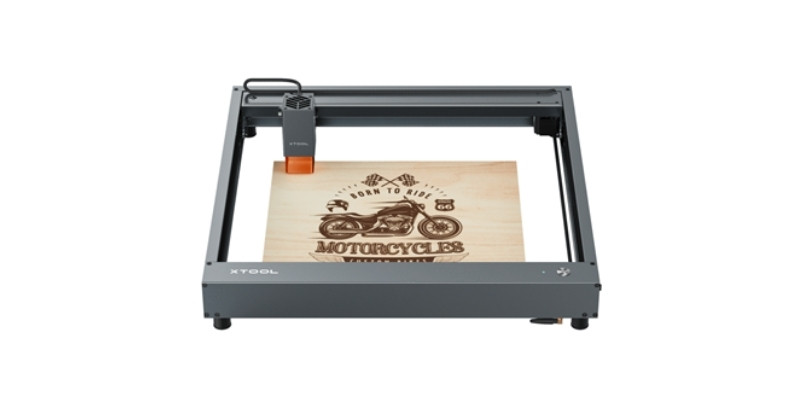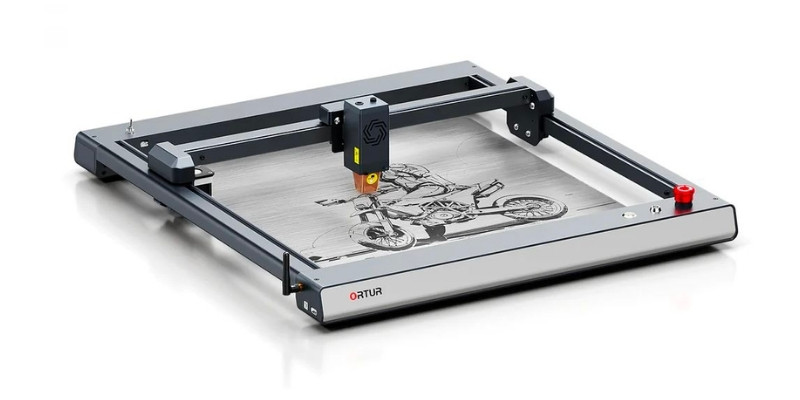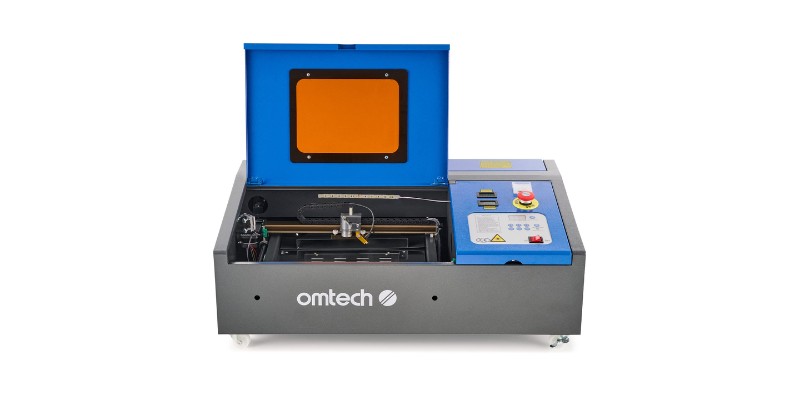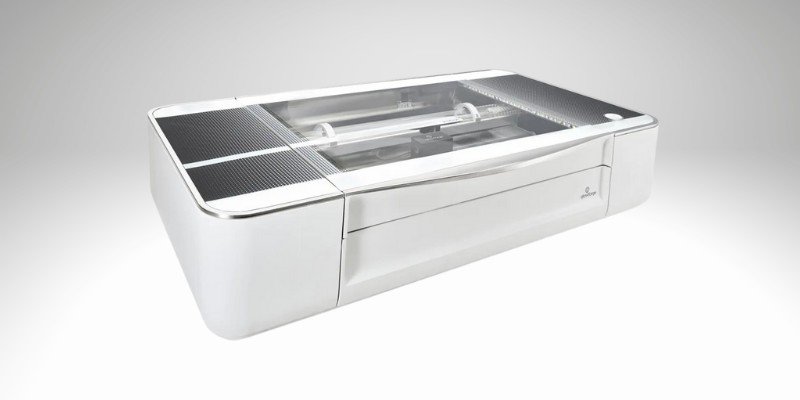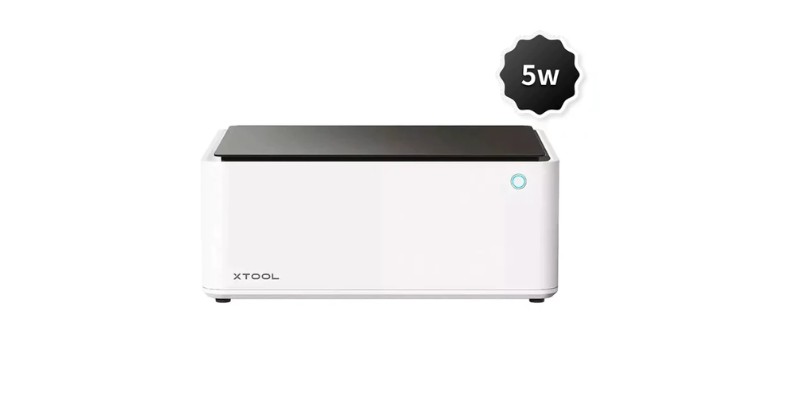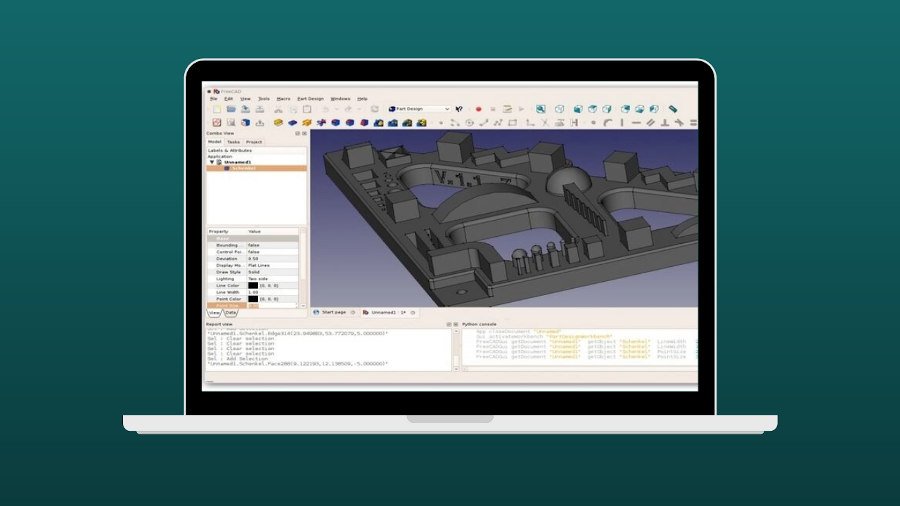On CNCSourced I talk about xTool products a lot. But they’re not the only options on the market, as a number of great xTool alternatives exist.
In this guide, I’ll review some of the most popular xTool alternatives. This includes seven different laser cutters for home use that can boost your side hustle and make every DIY project easier.
But before we give you xTool alternative options that do specific tasks better, let’s first explain what xTool lasers do well.
Full List of Alternatives
What the xTool D1 Pro Does Well
The D1 Pro comes in three power configurations: 5W, 10W, and 20W — and there’s now a 40W laser head accessory you can by for incredible power.
I personally opted for the xTool D1 Pro 20W, and I really like it. In fact, I honestly think it’s better than a lot of the alternatives out there, and if you want a safe bet, you should get the xTool.
And if you need even more power, go for the 20W version (we did!)
If you’re in the market for CO2 lasers, the xTool P2 is also excellent. I’m testing it at the moment and will update this very soon with my full hands-on review.
All three use the same chassis and their features are identical, except for the power and cutting depth (and a slight downgrade on the 20W version’s cutting area due to the larger laser head).
The D1 Pro is exceptionally good at engraving quickly – ideal for finishing projects fast. It also features the best build quality that we’ve seen at its price point: the D1 Pro uses all-steel wheels and shafts, solid metal framework, interlocking frame pieces that boost the rigidity, and a closed synchronous belt.
What does this mean for DIYers, hobbyists, and laser-cutting side hustlers? Fewer breakdowns, more reliability, and avoiding mechanical issues.
However, there are still reasons to consider an alterantive to the xTool D1 Pro, or xTool P2.
The Best Alternatives To xTool D1 Pro
1. Ortur LM3
- xTool D1 Pro 10W: Check latest price at xTool here
- Ortur Laser Master 3: Check latest price at Ortur here / Amazon here
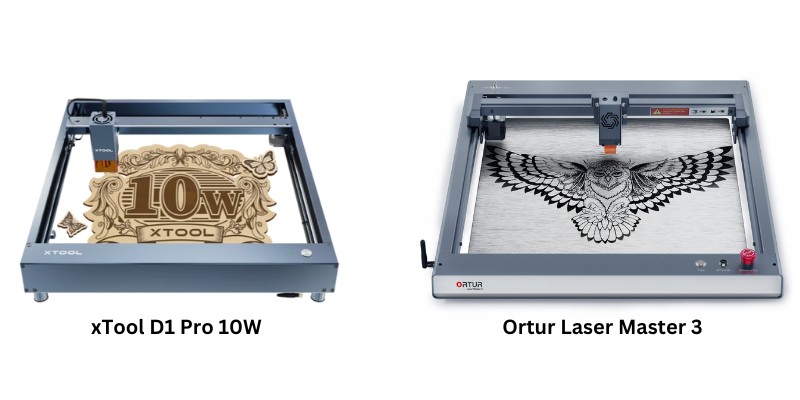
Pros
More safety features.
Compatible with free LaserGRBL.
Cons
Slightly worse build quality – for example, it has exposed belts whereas the xTool D1 Pro has protected belts.
I own both the Ortur Laser Master 3 and the xTool D1 Pro, and I’ve used both extensively, and they’re both great desktop diode lasers.
Both lasers offer 10W of cutting power, but the OLM3 cuts much deeper — up to 8mm on a basswood plywood sheet versus the 6mm that the D1 Pro 10W can handle. The OLM3 is also the same price as the xTool at $700.
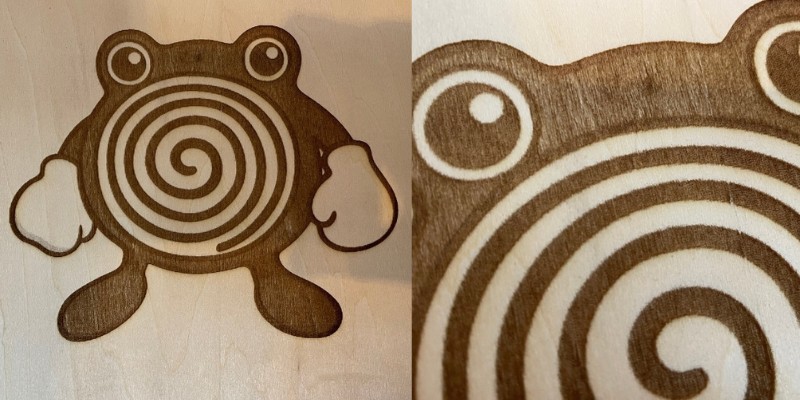
Their cutting speed varies a bit. The xTool can engrave 24,000 mm/min while the OLM3 can only manage 20,000 mm/min. The matchup is very close, and it’s ultimately a matter of preference.
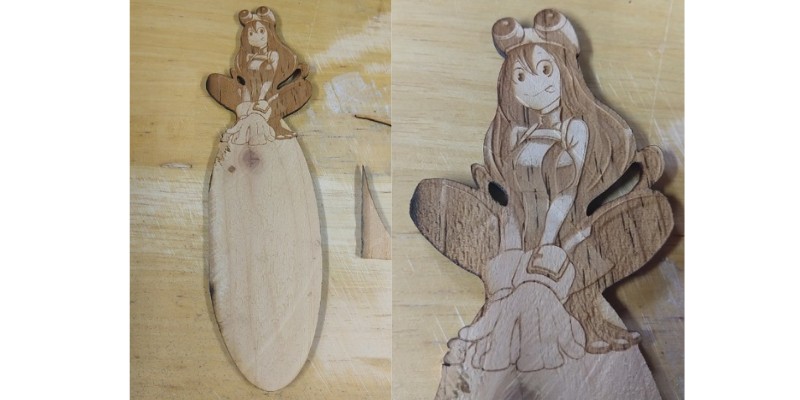
I own both these lasers, and have tested them on our site, and covered the comparison in far more depth in a separate article linked below. But to keep a long story short, they’re very similar, and the Ortur is safer, but I prefer the xTool overall for the better build quality.
Ortur's YRR Roller add-on is under $100 for low-cost beaker or glass engraving, and the laser itself is great value for 10W power.
2. xTool D1 Pro 5W vs Sculpfun S9
- xTool D1 Pro 5W: Check latest price at xTool here / Amazon here
- Sculpfun S9: Check latest price at Amazon here
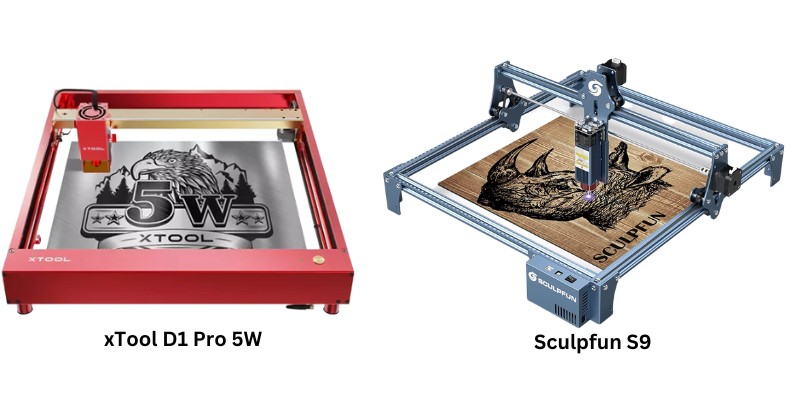
Pros
Cheaper than the xTool 5W.
Cuts much deeper.
Good working area.
Cons
Significantly slower.
| CATEGORY | xTool D1 Pro 5W | Sculpfun S9 |
|---|---|---|
| POWER | 5W | 5.5W |
| PRICE | $600 | $430 |
| SPEED | 24,000 mm/min | 6,000 mm/min |
| CUTTING DEPTH (ONE PASS) | 4mm basswood plywood | 10mm basswood plywood |
| CUTTING AREA | 400 x 430mm, upgradable to 936 x 430mm | 420 x 410 mm, upgradable to 950 x 410mm |
The Sculpfun S9 is another popular laser cutter, and a cheaper alternative to xTool – even when compared vs the cheapest xTool D1 Pro 5W version. These are both consumer-grade diode laser cutters and engravers.
Immediately, you’ll notice a few differences: the Sculpfun S9 is a lot more affordable, significantly slower, and cuts much deeper.
The S9 is a 5.5W laser, compared to the D1 Pro’s 5W laser configuration. The Sculpfun goes for $430, meanwhile the D1 Pro 5W costs $600. Why is there such a massive price difference? It largely has to do with the build quality and engraving speed.
The xTool is well-built. It uses impressive materials, plenty of engineering, and this all leads to high reliability. The team at Sculpfun favored affordability over build quality, so while it costs very little, it may run into some issues in the future.
What about the speed? The xTool is 4x faster than the Sculpfun S9. That means that a project that the S9 can do in 60 minutes will finish in 15 minutes on the D1 Pro 5W. This is unfortunate, especially if you want to finish projects quickly to sell.
The engraving area for both of these machines is pretty comparable, but the cutting depth isn’t. The cutting area for the D1 Pro is 400 x 430mm, but it upgrades to 936 x 430mm. The S9’s cutting area is 420 x 410 mm, upgradable to 950 x 410mm.
The S9 can cut plywood boards that are more than twice as thick as the D1 Pro can handle. The D1 Pro can manage a 4mm basswood plywood sheet, but the Sculpfun S9 can work on 10mm basswood plywood.
The verdict? I still personally think the xTool is the better option here for DIYers and people who run their own side hustle. The incredible speed and quality advantage of the xTool sets it apart. You can finish projects quicker with fewer mechanical issues.
However, pick up the Sculpfun S9 if you want a lower-priced cutter that can handle thicker boards of material.
3. xTool D1 Pro 5W vs LaserPecker 2
- xTool D1 Pro 5W: Check latest price at xTool here / Amazon here
- LaserPecker 2: Check latest price at Amazon here
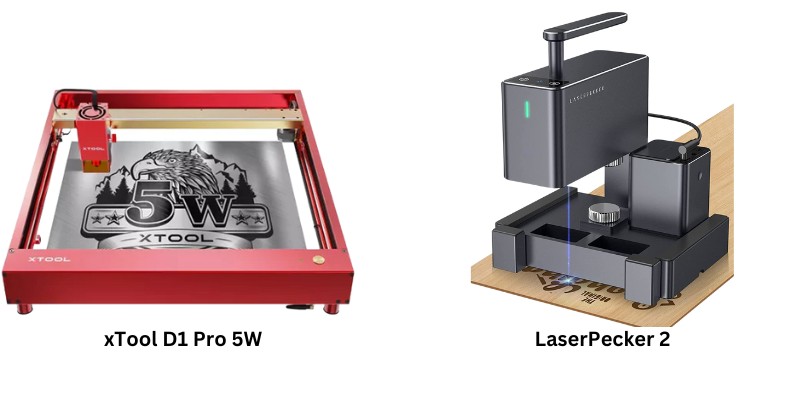
Pros
Portable and can be used as a handheld laser engraver.
Faster than xTool.
Cons
Small engraving area.
| CATEGORY | xTool D1 Pro 5W | LaserPecker 2 |
|---|---|---|
| POWER | 5W | 5W |
| PRICE | $600 | $600 |
| SPEED | 24,000 mm/min | 36,000 mm/min |
| CUTTING DEPTH | 4mm basswood plywood | 5mm basswood plywood |
| CUTTING AREA | 400 x 430mm, upgradable to 936 x 430mm | 100 x 100 mm |
The LaserPecker 2 (LP2) is a very unique diode laser engraver. It’s a smaller, portable machine with a handle on the top. You can hold the handle and use the machine as a handheld laser engraver — you can hold it against your wooden wall and engrave your design on the wall.
The other selling point of the LaserPecker 2 is how quick it is. We always mention how fast the D1 Pro is, but the LP2 is even faster!
A D1 Pro 5W can engrave up to 24,000 mm/min, while the LP2 can hit 36,000 mm/min — that’s 50% faster completion for every project.
The big downside of the LaserPecker 2 is its cutting area. You can only cut or engrave an area of 100 x 100mm, which is 4” x 4”. That’s barely the size of two credit cards next to each other.
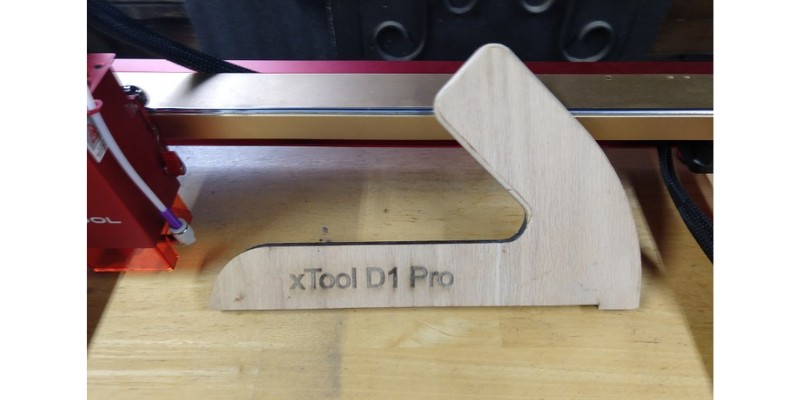
As far as cutting depth, both lasers are pretty close: for basswood plywood, the D1 Pro 5W can handle 4mm, and the LP2 can handle 5mm.
What about the price? These two laser engravers share an identical price: $600 each.
For us, the verdict isn’t as clear. If you’re someone who wants to make a ton of tiny engravings on material (like metal), then the LaserPecker 2 is the right option. If you ever need to do portable work, then it’s the only option. But if you want to work on larger pieces, then you’ll need the xTool D1 Pro 5W.
4. xTool D1 Pro vs OMTech K40
- xTool D1 Pro 10W: Check latest price at xTool here
- OMTech K40: Check latest price at Amazon here
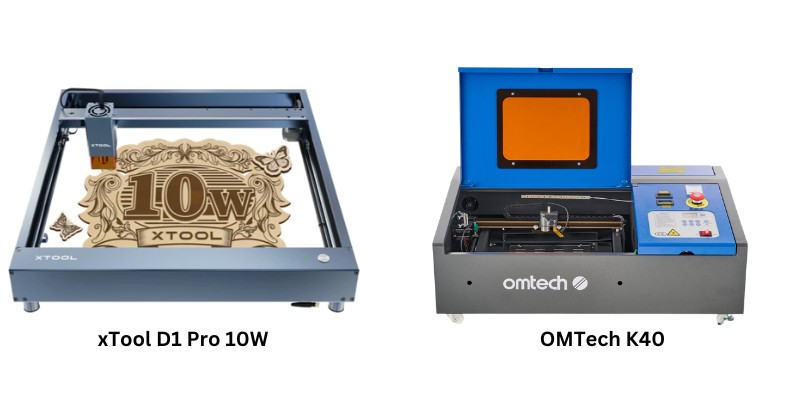
Pros
Powerful.
Can tackle a wider variety of materials.
Enclosed.
Much cheaper.
Cons
Very slow compared to xTool.
| CATEGORY | xTool D1 Pro 10W | OMTech K40 |
|---|---|---|
| MACHINE TYPE | Diode laser cutter/engraver | CO2 laser cutter/engraver |
| POWER | 10W | 40W |
| PRICE | $700 | $480 |
| SPEED | 24,000 mm/min | 15,300 mm/min |
| CUTTING DEPTH | 6mm basswood plywood | 6mm basswood plywood |
| CUTTING AREA | 400 x 430mm, upgradable to 936 x 430mm | 305 x 203 mm |
The first CO2 laser on our list is the OMTech K40. CO2 lasers are great at engraving and cutting non-metal pieces. They offer much stronger lasers, but are typically a lot more expensive.
Most CO2 lasers can handle a wider variety of materials than diode lasers can. Some diode lasers will struggle with white surfaces, glossy or smooth materials, or coated materials — CO2 lasers can easily engrave these.
That’s the case for the OMTech K40. It can tackle a wider variety of materials with fewer problems than the D1 Pro.
The K40 is an enclosed laser engraver with a lid that flips open, so you’re getting an enclosure included in the purchase price.
Even though the K40 offers 40W of cutting power, there is now a 40W laser head accessory for the xTool D1 Pro, but it costs $1100. And, 40W on a CO2 laser is very different than 40W on a diode laser cutter.
With the D1 Pro 10W, you get about 6mm of cutting power on basswood plywood in a machine that costs $700. Looking at the K40, you can cut the same 6mm of plywood, but only pay $480 for the machine, and it can cut and finish projects far faster.
Again, this is an unbelievably low price for a CO2 laser cutter. That’s probably why the OMTech K40 is the most popular budget CO2 option on the market.
There’s definitely a speed difference between the two. The D1 Pro can engrave at rates up to 24,000 mm/min, and the K40 tackles the same project at 15,300 mm/min (about 57% slower). But don’t read too much into this: the K40 can cut far faster because it’s a 40W CO2 laser.
Another difference between these two machines is the cutting area. The D1 Pro 10W’s cutting area starts at 400 x 430mm, and goes up to 936 x 430mm when you buy the extender. The K40 can only handle 305 x 203mm, and there’s no extending it.
When you’re looking at these two tools, I think the D1 Pro 10W is the better option for most standard projects. Even though it costs an extra $220, you get a faster speed and much larger cutting area.
However, you should pick the OMTech K40 if you need to work on a wider range of materials, put out projects faster for an Etsy or other DIY store, or you want to save the $220. It’s also enclosed (like all CO2 lasers), whereas you need a $160 enclosure accessory for the D1 Pro.
5. xTool D1 Pro 20W vs Glowforge Basic
- xTool D1 Pro 20W: Check latest price at xTool here / Amazon here
- Glowforge Basic: Check latest price at Glowforge here
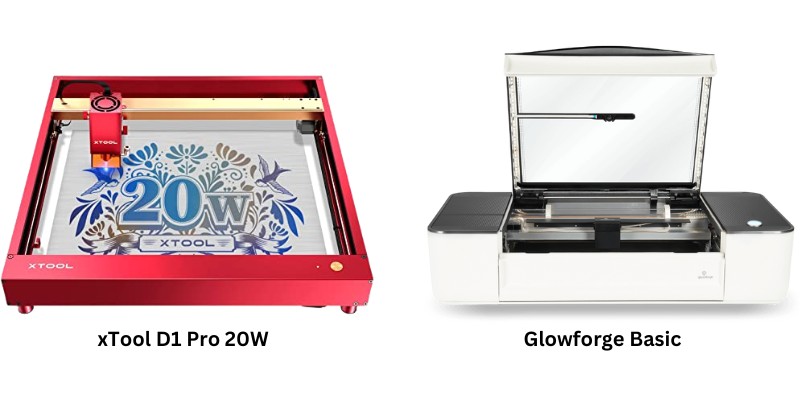
Pros
Has a live camera.
Can cut, engraver, and score on pieces up to 495 x 280mm.
Highly reliably.
Cons
Very expensive.
Another CO2 laser to consider is the Glowforge Basic. How does it match up to the xTool? Well, these two tools are in different leagues, in a lot of ways.
For one, the Glowforge Basic starts at $3,995. Compared to the $1,200 of the xTool D1 Pro 20W, that’s a huge difference.
The Glowforge has a live camera and can cut, engrave, and score on pieces up to 495 x 280mm. Comparatively, the D1 Pro can handle pieces up to 390 x 430mm or 936 x 430mm if you opt for the extension.
The Glowforge Basic is great at engraving, makes design simple, is highly reliable, and makes laser cutting easy. The D1 Pro can do the same, but not as well. This makes sense, since the xTool costs $2,800 less. Take a look at our complete comparison here.
Glowforge are the easiest to use lasers for home business owners looking to create cool projects and sell them on Etsy or other stores and make money.
6. xTool D1 Pro 5W vs NEJE 3 Pro
- xTool D1 Pro 5W: Check latest price at xTool here / Amazon here
- NEJE 3 Pro: Check latest price at Amazon here
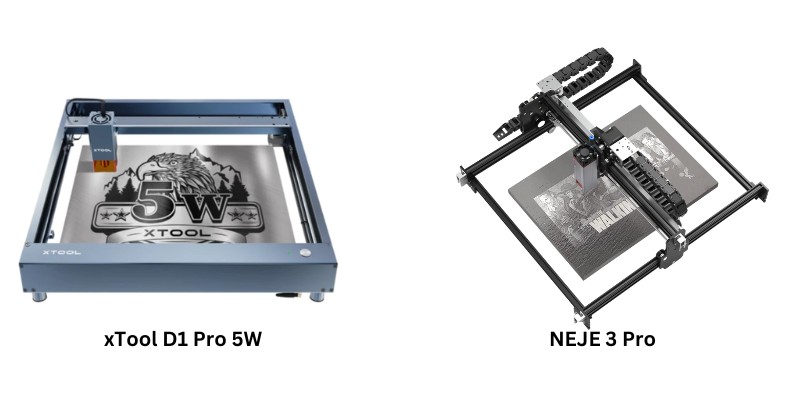
Pros
Extremely fast.
Can handle huge areas.
Costs very little.
Cons
Can only handle thickness of 3mm on basswood plywood boards.
Low-quality build.
| CATEGORY | xTool D1 Pro 5W | NEJE 3 Pro |
|---|---|---|
| POWER | 5W | 5.5W |
| PRICE | $600 | $360 |
| SPEED | 24,000 mm/min | 60,000 mm/min |
| CUTTING DEPTH | 4mm basswood plywood | 3mm basswood plywood |
| CUTTING AREA | 400 x 430mm, upgradable to 936 x 430mm | 410 x 400mm, upgradable to 1030 x 400mm |
NEJE is a less popular brand, and their big focus is making lasers that cut fast, can handle huge areas, and cost very little. The NEJE 3 Pro is a great example of this.
The NEJE 3 Pro is a 5.5W laser cutter, and the D1 Pro is a 5W. Even so, the D1 Pro can handle cutting 4mm basswood plywood boards while the 3 Pro can only handle 3mm.
As far as cutting areas, the square mm area is comparable: the D1 Pro offers 400 x 430mm, upgradable to 936 x 430mm, and the NEJE 3 Pro can cut up to 410 x 400mm, upgradable to 1030 x 400mm (a difference of 7% and 2% total area).
The speed gap is pretty huge. From 24,000 mm/min on the D1 Pro up to 60,000 mm/min on the NEJE 3 Pro. The D1 Pro is already one of the faster options on the market, so it’s hard to believe that the NEJE 3 Pro can go that fast.
With this speed difference, a 60-minute project on the D1 Pro only takes 24 minutes on the NEJE 3 Pro. However, it’s not like you can cut thick wood in single passes at this kind of speed – it’s for very light engraving at best.
But, what about the build quality? There is a big divide between these two cutters. The NEJE 3 Pro uses low-quality material and the assembly isn’t that sturdy. You’ll run into reliability issues and you’ll have to do mechanical troubleshooting more often. With the D1 Pro 5W, this happens much less often.
So, the NEJE 3 Pro might engrave faster, but you’ll have more downtime in the future.
This comparison is a lot closer. I think the NEJE 3 Pro is the better cutter on paper, but the reliability issue leaves such a mark on this cutter. It’s also really tough to get support from NEJE whenever you run into issues. Is it worth saving $240? It’s your choice.
7. xTool M1 5W vs Cricut Maker 3
- xTool M1 5W: Check latest price at Amazon here
- Cricut Maker 3: Check latest price at Amazon here
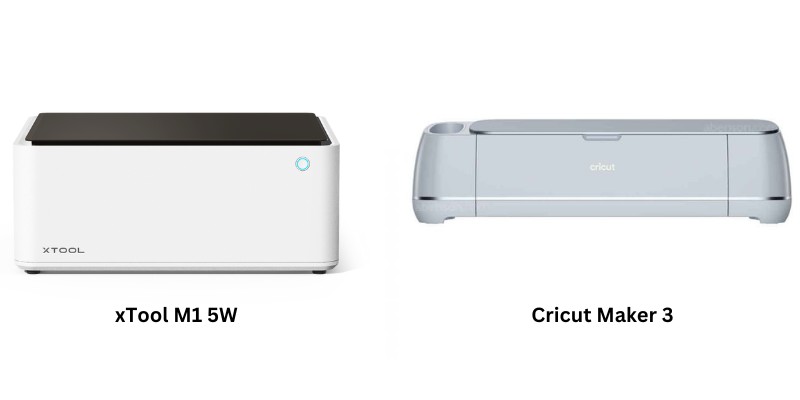
Pros
A 3-in-1 machine.
Can handle paper and make intricate cuts out of thin, delicate material.
Much better working area.
Cons
If you’re uninterested in its 3-in-1 capabilities, then stick with xTool.
| CATEGORY | xTool M1 5W Basic | Cricut Maker 3 |
|---|---|---|
| MACHINE TYPE | Diode laser engraver and blade cutter | Smart blade cutter |
| POWER | 5W | N/A |
| PRICE | $810 | $380 |
| MATERIAL OPTIONS | Fabric, paper, leather, metal, wood, ceramic, glass, etc. | Fabric, paper, leather, etc. |
| WORKING AREA | 385 x 300mm | 152 x 22800mm w/ roll holder |
Another option on xTool’s catalog is the M1. This is a 3-in-1 machine that features a laser cutter and engraver, and a physical blade for making cuts. It means that you can do more from a single machine.
Compared to the D1 Pro, the M1 can handle paper and make intricate cuts out of thin, delicate material. Trying to cut glossy paper on a D1 Pro will be a mess, but it’s easy on the M1.
If you want to cut fabric, paper, and matboard, you can also consider the Cricut Maker 3. Unlike xTool’s option, the Cricut is strictly a physical cutter (there is no added laser cutter or engraver).
Since the M1 is so unique, it’s tough to find a truly comparable machine.
The Cricut Maker 3 is very good at cutting fabric, paper, leather, and delicate material. It has a series of different physical blades you can install in the machine to enhance the results of your project. But that’s where it ends.
The M1 5W Basic does all of this and more. It can handle the same material with its physical cutter, plus a whole host of materials with its laser engraver.
As far as the working area, the Cricut Maker 3 is a lot better. It has a smart roll holder that will feed a roll of material right into the cutter. The width dimension is only 152mm, but the length dimension can go up to 22.8m The M1 5W Basic can only handle material up to 385 x 300mm.
Of course, there’s a price difference here. The xTool M1 5W Basic starts at $810 while the Cricut Maker 3 goes for $380. Is the extra money worth it? We really think so.
If you are strictly looking for a physical blade cutter, the Cricut Maker 3 is probably the better option. You get great functionality at an affordable price. If you want to expand the usability of your machine, then you need the xTool M1. It is a 3-in-1 machine that does so much.

